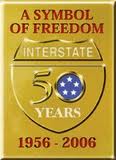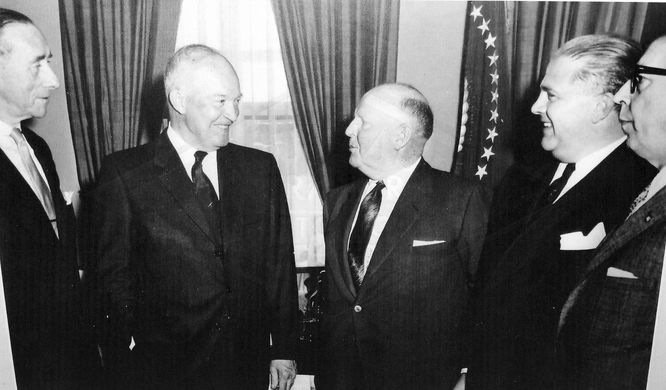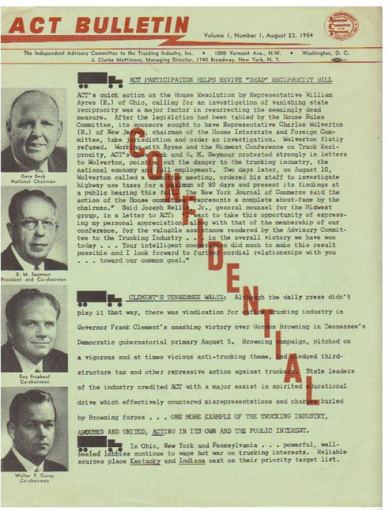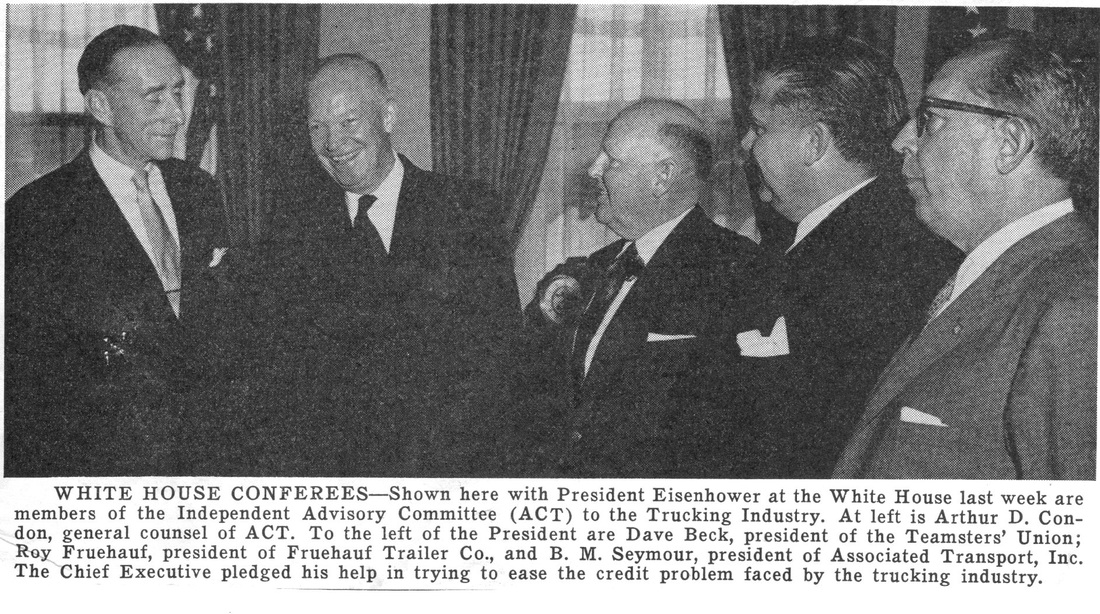Roy Fruehauf advises the Eisenhower Administration
WORKING WITH EISENHOWER
THE INDEPENDENT ADVISORY COMMITTEE
TO THE TRUCKING INDUSTRY (A.C.T.)
The following article contains excerpts from a new book on the history of Roy Fruehauf and the Fruehauf Trailer Company.
********************
Roy Fruehauf was a veteran employee by the time he took on the presidency in May 1949. He had worked his way up from apprentice salesman to executive vice president before taking leadership of the company. The fact that he wasn’t a college graduate had little bearing on the management skills that came natural to him.
Within the first few years as president of Fruehauf Trailer Company Roy would meet numerous famous and influential individuals; however two of them would stand out. Both held the title of ‘President.’
In 1951 Roy met Dave Beck, a man who would become General President of the Teamsters Union in 1952. On January 30, 1953 Roy would find himself in the oval office of the White House where he would be introduced to the newly elected President of the United States, Dwight D. Eisenhower. During his association with these two U.S. icons, Roy would become a participant in an historical project, begun during President Harry Truman’s administration, and later serving under President Dwight D. Eisenhower’s oversight and personal direction. Roy’s contribution would help change the face of America, and the country’s highway system.
To be fair, gaining a clear picture of this massive project, we actually need to travel further back than President Eisenhower’s era. Thomas Jefferson was one of the first Presidents to understand the importance of erasing the borders of our country’s states and territories as early as 1800. The states thought of themselves as separate entities, even separate countries. Joining them by new and improved roads would erase those borders. Jefferson’s launching of the exploration of Lewis and Clark on their search for the Northwest Passage marked the first major advancement toward the physical union of our United States.
This project would be unending, and often fraught with major obstacles. The importance of moving goods, and people, from one place to another has been a continuing problem since the Pilgrims landed at Plymouth. The key to protecting our country’s national defense, and keeping its products and services in motion, is our roadway system. President Franklin D. Roosevelt appointed a committee to study a national interregional highway system, but the attack on Pearl Harbor threw our country into the war and put the study on hold.
The earlier programs to review a nationwide highway system neglected the accommodation of trucks and tractor-trailers that had the greatest potential of moving goods around the country. This is where Roy Fruehauf entered the picture.
THE INDEPENDENT ADVISORY COMMITTEE
TO THE TRUCKING INDUSTRY (A.C.T.)
The following article contains excerpts from a new book on the history of Roy Fruehauf and the Fruehauf Trailer Company.
********************
Roy Fruehauf was a veteran employee by the time he took on the presidency in May 1949. He had worked his way up from apprentice salesman to executive vice president before taking leadership of the company. The fact that he wasn’t a college graduate had little bearing on the management skills that came natural to him.
Within the first few years as president of Fruehauf Trailer Company Roy would meet numerous famous and influential individuals; however two of them would stand out. Both held the title of ‘President.’
In 1951 Roy met Dave Beck, a man who would become General President of the Teamsters Union in 1952. On January 30, 1953 Roy would find himself in the oval office of the White House where he would be introduced to the newly elected President of the United States, Dwight D. Eisenhower. During his association with these two U.S. icons, Roy would become a participant in an historical project, begun during President Harry Truman’s administration, and later serving under President Dwight D. Eisenhower’s oversight and personal direction. Roy’s contribution would help change the face of America, and the country’s highway system.
To be fair, gaining a clear picture of this massive project, we actually need to travel further back than President Eisenhower’s era. Thomas Jefferson was one of the first Presidents to understand the importance of erasing the borders of our country’s states and territories as early as 1800. The states thought of themselves as separate entities, even separate countries. Joining them by new and improved roads would erase those borders. Jefferson’s launching of the exploration of Lewis and Clark on their search for the Northwest Passage marked the first major advancement toward the physical union of our United States.
This project would be unending, and often fraught with major obstacles. The importance of moving goods, and people, from one place to another has been a continuing problem since the Pilgrims landed at Plymouth. The key to protecting our country’s national defense, and keeping its products and services in motion, is our roadway system. President Franklin D. Roosevelt appointed a committee to study a national interregional highway system, but the attack on Pearl Harbor threw our country into the war and put the study on hold.
The earlier programs to review a nationwide highway system neglected the accommodation of trucks and tractor-trailers that had the greatest potential of moving goods around the country. This is where Roy Fruehauf entered the picture.

In early 1951 a group of people, all connected to the trucking industry, formed the Independent Advisory Committee to the Trucking Industry (A.C.T.). The group incorporated in the State of Delaware. The purpose of this committee was to unite members who could lobby for truck manufacturers, truck owners and labor to work out problems for the trucking industry. One of the original reasons the committee was organized was for the purpose of obtaining steel with which to manufacture trucks during the Korean War. At that time the United States Government was not allocating steel for that purpose. The Internal Revenue Service recognized the committee as a trade association which meant that the committee was for the benefit of the whole industry and not for the benefit of one company or a small group of persons. Dave Beck, Roy Fruehauf, Burge Seymour and Arthur Condon were among the first committee members. Dave Beck served as chairman. Seymour joined the group in January 1953. The committee would eventually become inactive about 1957.
In the 1930s, President Franklin D. Roosevelt proposed the need for construction of an interstate highway system. His deepest concern was to put Americans back to work during and after the Great Depression. Roosevelt passed legislation, pursuing a variety of avenues that would help bring about the beginning of this immense project. The dream was to create a highway system that could accommodate the country’s growing traffic needs over the next several decades.
The actual construction moved very slowly. As this would be a massive project touching every State in the country, naturally there were obstacles to getting agreement from the States through each phase of the endeavor. The first funds that were specifically designated for construction of the interstate system were on a 50-50 matching basis. Twenty five million dollars was authorized by the passage of The Federal-Aid Highway Act of 1952.
On January 20, 1953 Dwight D. Eisenhower took office. He had long realized the importance and need for an improved highway system. During his days in the U.S. Army, he had to run convoys that used the failing roads system of the early 1900s. He dealt with mud, narrow roadways and inadequate bridges. Carrying on the work begun by Roosevelt was a primary concern when he began his first term in office.
President Eisenhower learned of the existence of the A.C.T. when Dave Beck contacted him. On January 30, 1953, ten days after Eisenhower entered office, in response to Beck's letter the President made an appointment to meet several of the committee members. Roy Fruehauf was among those members. A notation can be found in President Eisenhower’s Daily Appointment Book, an entry showing that Roy Fruehauf, B.M. Seymour, Arthur Condon and Dave Beck met with the President in his White House office on that afternoon from 2:30 to 3:00 p.m. The stated purpose was to discuss “pressing problems of the trucking industry.”
It was during this meeting that President Eisenhower invited the ACT to join forces with him in his effort to prepare a presentation to bring to Congress, a presentation that would obligate the government to provide funding to get the interstate highway system ‘on the road.’
President Eisenhower learned of the existence of the A.C.T. when Dave Beck contacted him. On January 30, 1953, ten days after Eisenhower entered office, in response to Beck's letter the President made an appointment to meet several of the committee members. Roy Fruehauf was among those members. A notation can be found in President Eisenhower’s Daily Appointment Book, an entry showing that Roy Fruehauf, B.M. Seymour, Arthur Condon and Dave Beck met with the President in his White House office on that afternoon from 2:30 to 3:00 p.m. The stated purpose was to discuss “pressing problems of the trucking industry.”
It was during this meeting that President Eisenhower invited the ACT to join forces with him in his effort to prepare a presentation to bring to Congress, a presentation that would obligate the government to provide funding to get the interstate highway system ‘on the road.’




